Stochastic Analysis of a Hassell-Varley Type Predation Model
Abstract
We investigate a Hassell-Varley type predator-prey model with stochastic perturbations. By perturbing the growth rate of prey population and death rate of predator population with white noise terms, we construct a stochastic differential equation model to discuss the effects of the environmental noise on the dynamical behaviors. Applying the comparison theorem of stochastic equations and Itô’s formula, the unique positive global solution to the model for any positive initial value is obtained. We find out some sufficient conditions for stochastically asymptotically boundedness, permanence, persistence in mean and extinction of the solution. Furthermore, a series of numerical simulations to illustrate our mathematical findings are presented. The results indicate that the stochastic perturbations do not cause drastic changes of the dynamics in the deterministic model when the noise intensity is small under some conditions, but while the noise intensity is sufficiently large, the species may die out, which does not happen in the deterministic model.
1. Introduction
It is well known that predator-prey interaction is one of basic interspecies relations for ecosystems, and it is also the basic block of more complicated food chain, food web, and biophysical network structure [1]. Because of the universal existence of predator and prey and their importance in ecology, the dynamical relationship between them has long been and will continue to be one of the dominant themes [2, 3].
On the other hand, most natural phenomena do not follow strictly deterministic laws but rather oscillate randomly about some average. So that the population density never attains a fixed value with the advancement of time but rather exhibits continuous oscillation around some average values [12, 13]. In fact, there are many benefits to be gained by using stochastic models because real life is full of random fluctuations (i.e., the effects of noise), which undeniably arise from either environmental variability or internal species. The basic mechanism and factors of population growth like resources and vital rates—birth, death, immigration, and emigration—change nondeterministically due to continuous fluctuations in the environment (e.g., variation in intensity of sunlight, temperature, water level, etc.) [2, 3, 14]. Recent advances in stochastic differential equations enable a lot of authors to introduce noise into the model of physical phenomena, whether it is a random noise in the system of differential equations or environmental fluctuations in parameters [15–31]. So far as our knowledge is concerned, the work of a modified Hassell-Varley type predator-prey model with stochastic perturbations seems rare. Motivated by these, we attempt to study the stochastic behaviors of the modified Hassell-Varley type predation model in a random fluctuating environment.
The organization of this paper is as follows. In Section 2, we present a stochastic model corresponding to the deterministic model (4) and discuss it in detail. In Section 3, we use numerical simulations to reveal the influence of noise on the dynamical behaviors of the model. A brief discussion is given in Section 4.
2. The Stochastic Model and Analysis
2.1. Positive and Global Solution
For model (6), there is a positive local solution.
Lemma 1. There is a unique local solution (N(t), P(t)) for t ∈ [0, τe) to model (6) almost surely for initial value , where τe is the explosion time.
The proof of this lemma is rather standard and hence is omitted.
Lemma 1 only tells us that there is a unique positive local solution to model (6). Next, we show that this solution is global which is more interesting.
From the representation of solutions , , , and , we can see that they are all existence for t ∈ [0, ∞); that is, τe = ∞. Therefore, we have the following theorem to show that the positive solution of model (6) is global, which is essential for a population system.
2.2. Stochastic Boundedness
In this subsection, we show that the solution (N(t), P(t)) of model (6) with any positive initial value is uniformly bounded in mean.
Theorem 3. The solution (N(t), P(t)) of model (6) with any positive initial value has the property that
Proof. From (7), we obtain
Set
2.3. The Long Time Behavior
It is well known that the property of permanence is more desirable since it means the long time survival in a population dynamics. Now, the definition of stochastic permanence will be given below [32, 33].
Definition 4. The solution (N(t), P(t)) of model (6) is said to be stochastically permanent, if, for any ɛ ∈ (0,1), there exists a pair of positive constants δ = δ(ɛ) and χ = χ(ɛ) such that, for any initial value , the solution (N(t), P(t)) to model (6) has the properties that
Lemma 5. For any initial value , the solution (N(t), P(t)) satisfies that
Proof. Set a function
Let k > 0 be sufficiently small such that it satisfies (31); by Itô’s formula, then
In addition, we know that (N + P) θ ≤ 2θ(N2 + P2) θ/2; consequently,
Based on the results of Theorem 3, Lemma 5, and the Chebyshev inequality [14], we can obtain the following theorem.
Theorem 6. Assume that ; the solution of model (6) is stochastically permanent.
In a view of ecology, the coexistence of species may be a good situation. In the following, we consider the stochastic persistence (i.e., stochastic persistence in mean) of the species.
Theorem 7. Assume that holds, for any initial value N0 > 0; then the solution N(t) to model (6) has the property
Proof. Denoting V(N) = ln N and by Itô’s formula, we obtain
Letting t → ∞, we know that
On the other hand,
Theorem 8. Assume that holds and that (N(t), P(t)) is the solution of model (6) for any initial value ; then
Proof. Denoting V(P) = ln P and by Itô’s formula, we have
Furthermore,
2.4. Extinction
Combining the above arguments, we can get the theorem as follows.
Theorem 9. Let (N(t), P(t)) be the solution of model (6) with any initial value . If and , then
Based on the above, we obtain the following theorem which means that if the noise satisfies some conditions, then both species N and P of model (6) will die out.
Theorem 10. Let (N(t), P(t)) be the solution of model (6) with any initial value . If , then
3. Numerical Simulations
When choosing the values of parameters r = 2, K = 0.15, b = 0.8, c = 0.5, d = 0.1, m = 0.1, α = 0.2, and h = 0.1 for model (4), which has three equilibria in the positive quadrant, where E0 = (0,0) (total extinct) and E1 = (0.15,0) (extinct of the predator or prey only) are saddle points, E* = (0.023,0.2025) (coexistence of the prey and predator) is globally asymptotically stable. The trajectory of the prey and predator population of model (4) is shown in Figure 1.
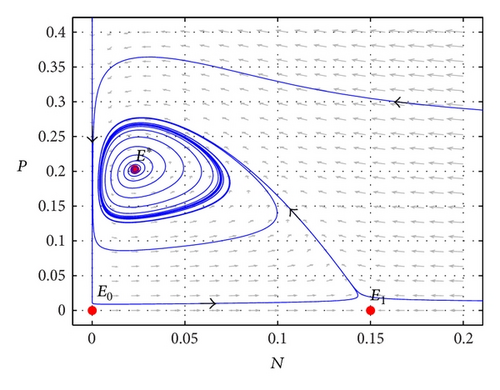
Figure 2 shows the time-series plots of model (6) with different noise intensities and . When choosing σ1 = σ2 = 0.045 (Figure 2(a)) and σ1 = 0.12, σ2 = 0.3 (Figure 2(b)), from Theorem 6, we know that the positive solution of model (6) is stochastically permanent, which means that stochastic perturbations do not change the permanence of the deterministic model (4). Moreover, from Theorem 7, the model will be stochastically persistent in mean. In other words, we can use the deterministic model (4) describing the dynamics of the stochastic model when the noise intensities and are small. From Figure 2(b), we can observe that the violent fluctuations appear as the noise intensities further increase. It means that noise has strong destabilizing effects on the model and the amplitude of the fluctuations in population density of prey and predator species increases obviously, implying instability of the coexisting equilibrium point in the stochastic environment.
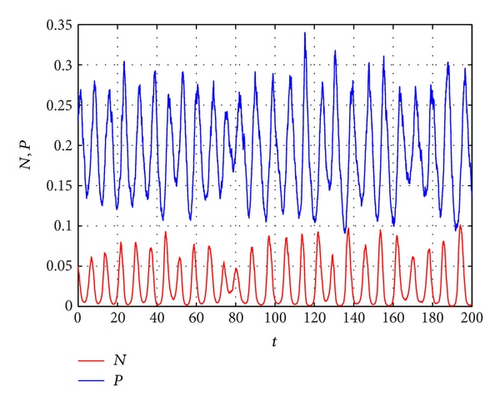
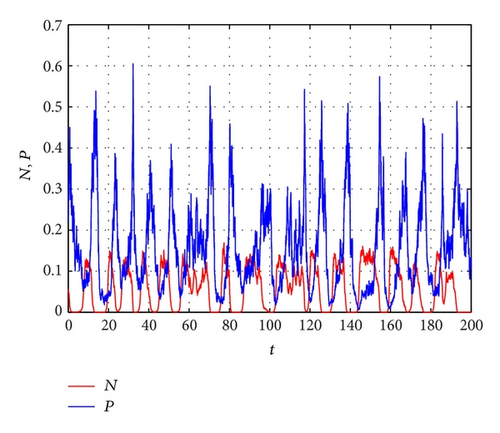
In Figure 3, we continue to choose different noise intensities and to consider the effects of noise to model (6). When choosing σ1 = 0.15 and σ2 = 0.9 (Figure 3(a)), the conditions of Theorem 9 are satisfied; then we can find that prey population N(t) of model (6) is permanent and predator population P(t) will die out. Choosing σ1 = 0.918 and σ2 = 0.6 in Figure 3(b), which satisfies the conditions of Theorem 10, both species N and P in model (6) become extinct. That is to say, big noise can make the two species die out. From the above numerical results and by Theorems 3, 6, 7, 9, and 10, we conclude that for some noise intensities and the dynamical behaviors of stochastically ultimately boundedness, permanence, persistence in mean, and extinction can be observed in model (6).
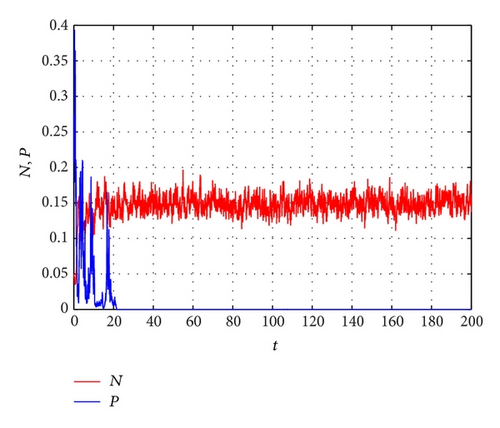
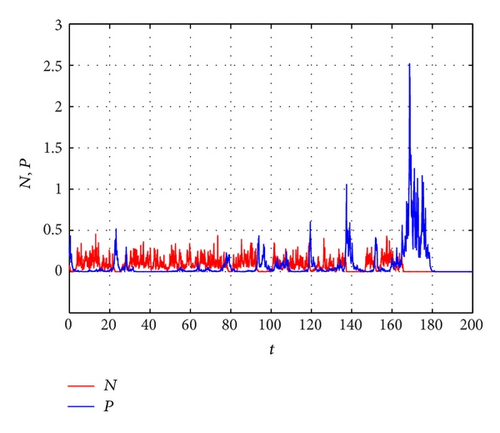
4. Conclusions and Remarks
In this paper, we consider a stochastic Hassell-Varley type predator-prey model. The value of this study lies in twofolds. First, it verifies some relevant properties of the corresponding stochastic model (6), which shows the global existence, boundedness and stochastic permanence, persistence in mean, and extinction of the positive solution. Second, it illustrates the dynamics of the model via numerical simulations, which shows that if the noise is not large and satisfies some conditions, the stochastic perturbations do not cause drastic changes of the dynamics in the deterministic model (4), while if the noise is sufficiently large and satisfies some conditions, it will force two species in the model to die out.
In order to study the stochastic model (6), we perturb the deterministic model (4) by incorporating white noise terms in the growth rate of prey population and in the death rate of predator population. Establishing a Lyapunov function, there is a unique positive solution to the model for any positive initial value. Applying Itô’s formula, we derive that, under some conditions, the solution of model (6) is stochastically bounded, permanent, and stochastic persistent in mean and extinct. For the fixed parameters r, K, b, c, d, m, α, and h, some conditions depend on the intensities of noise and noise . When the noise intensities satisfy some conditions of Theorem 9, we can find that prey population N(t) of model (6) is permanent and predator population P(t) will die out (see Figure 3(a)), while with the noise intensities increasing which satisfy the conditions of Theorem 10, from Figure 3(b), two species N and P will die out. In other words, when the noise satisfies some conditions of Theorems 6 and 7 and is not sufficiently large, the populations N and P may be stochastically permanent and persistent in mean, while large noise satisfying the conditions of Theorems 9 and 10 will force the population to become extinct. Our complete analysis of the stochastic model will give some suggestions to the studies of the population dynamics.
Conflict of Interests
The authors declare that there is no conflict of interests regarding the publication of this paper.
Acknowledgments
The authors thank the editor and the anonymous referees for the very helpful suggestions and comments which led to improvement of their original paper. This research was supported by the National Science Foundation of China (no. 11301263).




